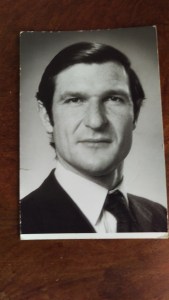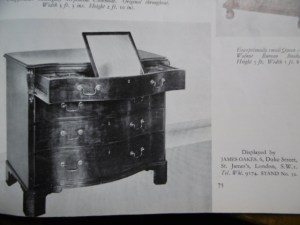We’ve had a huge amount of help and information on the history of the British Antique Trade from various people, and one of the most energetic supports of the project has been John Hudson – he has given us a variety of antique dealer ephemera, and also sent us these fascinating reflections on his life in the world of art & antiques, and from his time working at Christie’s auctioneers – and with the forthcoming celebrations of the 250th anniversary of Christie’s this year, we thought John’s memories would be of considerable interest. Anyway, Here’s John, in his younger days –
And here are John’s reflections –
“Looking back to the some 50 years ago when I first started at Christie’s in 1965 behind the Front Counter, the entire staff, including overseas offices, was about 120, and a turnover of £4.5 million. There were no Fax machines, photocopiers, the Internet, or digital cameras. The secretaries typed one off formal letters with a carbon copy, any mistake and the whole letter had to be redone!
The Main London Salerooms advertised their sales in the Daily Telegraph and The Times on Mondays and Tuesdays respectively, with the occasional provincial auctioneer included. To be informed about sales in the provinces the trade would subscribe to a press cuttings agency , Romeike, who would cut out the relevant advertisements out of the local papers and about twice a week post the group of clippings. The arrival of the Antiques Trade Gazette and photocopier were the death knell of this service.
At Christie’s there was a constant flow of private and trade clients to the front counter (this was before any Regional Offices opened, the early 1970s saw the first two , Shropshire and the West Country; Scotland and Ireland were a few years later) bringing in items for inspection and valuation for possible sale and for this purpose there were three small rooms and later four, where items could be unpacked and discussed discretely; if a client only brought in a single item or so we would take it up to the relevant department to be looked at to save the “expert” ( Christie’s preferred the term Technical Advisor) spending a lot of time going up and downstairs. If there were several items or a piece of importance then of course some one would come and see the client.
Something I noticed about the trade clients, those who came with items to sell, tended to be those that covered the Country Sales, in many case driving a significant mileage each week, bringing their discoveries as often they had no retail outlet. Also we saw a few Brighton knockers and the Irish knockers. I well recall one Brighton knocker telling me how they would advertise in the Shires, to say they were in the area, looking to buy pictures, silver, porcelain etc. when one winter, they received a letter with a heading or something similar like:- ” Ivy Cottage , Lower *****, *****shire. ” or words to the effect that the writer was a spinster and because of the weather she wished in due course to move into the nearby town and had a considerable amount of silver , china and pictures etc she wished to sell. There was no telephone number so the dealer and his associate changed their plans and immediately set off at short notice to see the lady concerned. After a considerable time spent in a fruitless search for the cottage, they called in at the local police station. The police checked their records and said as far as they were concerned the address didn’t exist and could it be that a local dealer or rival had written the letter!
Auction catalogues were available both illustrated and unillustrated, but with no estimates printed, and this in a curious way helped to alert if there was a possible sleeper, by undue interest, as verbal estimates were available on request. Printed price lists with the names of buyers as well as “bought in” names after the sale cost 5/- or 25p, often more than the cost of the original catalogue ( this was an historic quirk as the young clerks originally supplemented their income by writing up the catalogue with the prices realised and the buyers names for various members of the trade, some had as many as 20to 30 dealers covering the different categories charging 5/- each sale). Although the porters in Christie’s weren’t allowed to bid for a client, senior staff were; history relates that the Chief Sales Clerk at Christie’s, before the Second World War, was able to employ a butler and gardener on the strength of his tips. When I arrived at Christie’s South Kensington in 1977 the porters had been allowed to bid in sales with the previous firm Coes, and many of them were already home owners.
In London up to the early 1980s there was a furniture sale every day of the week each saleroom having their own designated day. In the Season at Christie’s, which usually ran from late September, with perhaps a House sale or two earlier in the month, until July the following year, with a 3 week break at Christmas, would see:-
Monday, ceramics, English, Continental, or Chinese Porcelain
Tuesday, Watercolours/drawings/prints and or Japanese works of Art, or Works of Art & objects of vertu or Antiquities
Wednesday, Silver and or Jewellery,
Thursday, Furniture, Wine and sometimes Books
Friday, Paintings, various categories, English, Continental, Old Masters, Modern British, Impressionist
Christie’s were renowned for selling in Guineas; this was because in the very early days the 0ne shilling difference was the vendors commission. Guineas ceased on decimalisation in 1972.
I should perhaps mention how I started my career in the Auction World. At Christie’s the foreman Porter at the time Jim Taylor hired and fired the porters, unless they were student porters. In the 1960s many of the porters had served in the same Regiment as the Partners (Directors) during WWII; also a number were related by marriage. The young Clerks in the general office were selected by the Headmaster of a School near Pimlico who sent his brightest pupils, at the end of the Summer Term, just in time for the start of the new season. The girls were interviewed by Mrs Andrews who ran the filing room. The Directors usually chose and interviewed their own secretary, sometimes a girl whose family might have an interesting Painting or Collection.
I was fortunate that my Great Uncle and Aunt had had antiques shops in both Bury Street and Duke Street since the 1920s till early 1960s, and had known many of the directors at Christie’s for a considerable time. Christie’s was bombed by incendiaries during WWII, but because there were fire pickets on duty during that night (a member of the picket John Hancock was working at Christie’s up until the 1980s) they were able to save the archives including all the auctioneers books since Christie’s foundation in 1766, as well as the day books going back to the 1840s. Christie’s was rebuilt after WWII and re-opened in the Autumn of 1953. Everything that came in for sale was able to be stored on the premises including furniture, it was only as late as about 1969 that the furniture was moved out to a warehouse (Hudsons just across the road from platform 1 at Victoria Station, ) now long gone.
My Great Uncle and Aunt were James Oakes and Amy Oakes. Uncle served in World War1 with the South Staffordshire Regiment, he was a skilled clock maker and in his house he had a Year Clock, a Month clock and an 8 day clock, all made by him. He was keen on engineering and always used to have a Buggatti car. He had premises next to the Aolian Hall in Bond Street, opposite Sothebys, but moved to Bury St St James’s because of the noise from the musicians. After World War II , he moved to Duke Street, St James’s. (Here’s an advertisement by James Oakes, in the Grosvenor House Antiques Fair Handbook, 1950).
After Christie’s was rebuilt in 1953 my Uncle supplied the clock in the main saleroom and in the anti-room, which were each situated above the main door. My Aunt also had a shop, in The Old Bailey close to the Criminal Court, where she sold jewellery, early English porcelain, pocket watches, and possibly silver. Her shop was one of the few shops to survive the bombing in WWII and was pulled down in the 1950s. My Uncle took out a 15 year lease (for I believe £5,000 a year) on a three storey building 121 New Bond Street in 1960, but died a year later. So my Aunt took over the shop until the very late 1960s when sadly dementia took its toll and she was no longer able to continue.”
Fascinating stuff John…thank you for sharing this with the Antique Dealer Research project!
Mark

